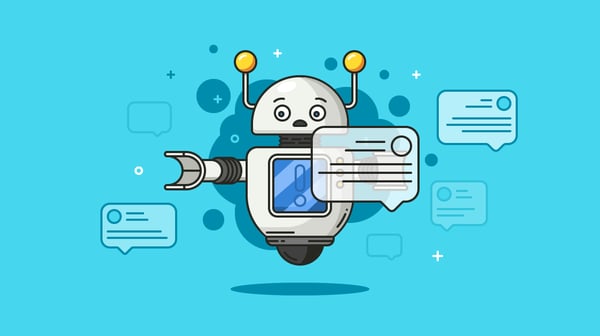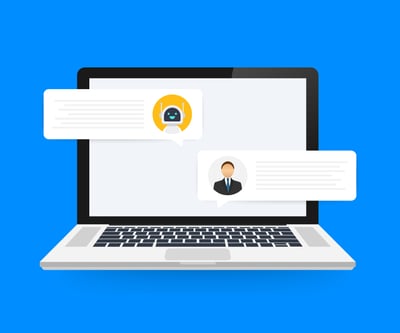September 30, 2019
 by Shay Berman / September 30, 2019
by Shay Berman / September 30, 2019

It’s the battle of the bots.
In just the past few years, marketers and business owners have seen a dramatic shift in business-to-communication, and it’s turning out to be pretty profitable. We’re talking double the conversions.
Think about it this way: if a website visitor expects a webpage to load in less than five seconds, how long can you expect them to wait for the answer to a question? A day? An hour? Try 10 minutes or less.
Instant messaging software has revolutionized how businesses communicate with prospects and generate leads. But while the role of artificial intelligence in digital marketing is on the rise, there’s still something to say for the human touch.
We then enter the live chat vs. chatbots for business debate. They bother have a lot to offer businesses and customers alike that are in need of assistance; however, choosing which one will yield the results needed isn’t always so clear. Here’s what you need to take into consideration when making the final decision.
We are in a world run by virtual assistants. One assistant growing in popularity is the chatbot. A chatbot is an instant messenger pre-programmed with responses.
Located on your social media – Facebook Messenger is one chatbot you’re sure to be familiar with – or your website, a chatbot creates guided conversation with users needing answers.

Chatbots can be signaled with rules using calls-to-action or even pick up on context clues. This allows for customers to get in contact with your business without the inconvenience of a wait time and without your company needing an actual person on the other side of the screen.
|
TIP: Find chatbot software solutions for your company's needs on G2. |
Live chat for business is a variation of your standard chatbot. The difference is that this real-time, instant messaging software puts visitors in contact with a human representative.

A trained agent can answer customer service queries, take down lead information, and more in a matter of minutes. This all allows you to build a personal connection with a chatter and provide case-by-case solutions, all while increasing your potential to engage with new, potential business and maintaining trust with repeat customers.
Tip: Discover the best live chat software, compare features, pros and cons, and find the right fit for your team.
When we’re talking about instant messaging, we’re not referring to the early 2000s and AIM. Instant messaging systems have come a long way, and are a direct line to your getting online visitors into the funnel.
Live chat tools and chatbots are directly correlated to an increase in sales, higher customer satisfaction, improved bounce rate, and more repeat customers. This is because chat systems are proactive. They start the conversation with the visitor, providing a convenient place for communication to take place rather than having the visitor search for the answer.
Not to mention, messaging systems come with an affordable price tag with a quicker return on investment than traditional methods of B2C communication, including phone and email.
First things first: Why are considering using a messaging system? Do you want to convert more website visitors? Are you looking to sell tickets to events? Or are you trying to improve customer satisfaction in general?
Live chat and chatbots have their respective strengths and weaknesses. So, having a clear view of your goals and what you hope to achieve with a messaging system will give help you stay on track moving forward.
Step two in determining live chat or a chatbot is figuring out where the missed connections are.
If you have a growing community on social media and are seeing messages come in with frequently asked questions, then a chatbot may be exactly what you need. For instance, Facebook Messenger allows you to set up answers in a rule-based conversation. This means certain words or phrases trigger a message, guiding the chatter to provide the necessary information.
But, if you have website visitors that are never making their way to checkout after filling up a cart, live chat could be the answer to yours and their question. 50% of consumers say having an actual person available to answer their questions during online shopping is on of the most important features of a buying experience.
On average, it can take a business up to 12 hours to respond via email. On social media, you’re looking at about 10 hours of wait time. Live chat and chatbots cut wait times down significantly, making them the preferred method of contact.
When weighing the efficiency of live chat or a chatbot, you need to consider what your customer is asking. Are visitors more-so needing basic information, including store hours, return policies, or contact information? Or are inquiries technical, like product usage details, quotes, or appointment scheduling?
Live chat excels when it comes to the complicated, technical messages. A human agent can provide an answer and solution in two minutes or less, on average.
But, live chat falters when it’s not business hours. Say your agent is only online Monday through Friday 9 AM to 5 PM. What happens after hours? Typically, a contact form is available for the agent to address queries come the next morning, racking up your response time and number of potential customers without assistance.
Chatbots, on the other hand, answer instantaneously no matter the time or day. This appeases the 51% of users who believe brands should have 24/7 service. Automated responses are pre-written, allowing for guided conversation to occur with ease on your website and social media without necessitating man or woman power.
The goal of both live chat and chatbots is to provide clear communication between a chatter and a company. Chatbots can answer the simplest of questions with ease, and so can live chat. However, live chat takes the cake here.
Bots are still limited when it comes to human interaction. Context and intent are not exact sciences, and most chatters are using instant messaging for a select few things, including emergency resolution, resolving complaints, getting detailed answers to a question, and finding a human customer service assistant.
A human agent is able to gauge a chatter’s mood, comprehend technical language, and adjust on a dime for unique requests. This aspect of live chat alone can score you more leads and happy customers.
Truth be told, both of these systems are really self-explanatory, assuming your average user understands how a chatbot works.
On a chatbot, a user typically engages with guided conversation. They might be prompted with call-to-action buttons or automated questions. In a live chat window, the user has all of the control. They lead the conversation with their question and an agent follow suit.
Surprisingly, the freedom of live chat makes things simpler – which isn’t always the case when it comes to customer service and lead generation. Asking a chatter to categorize their inquiry on a chatbot isn’t always intuitive. A live chat is just like any other conversation, meaning there’s no learning curve.
There’s no beating around the bush. People trust people. Seriously. Think about how often you’ve had to ask for a representative on the phone.
Bots and technology warrant skepticism and users aren’t always so keen on sharing personal information with an automated system. Knowing that there’s another human being on the other side of the chat, gives live chat a huge upper hand here.
In fact, 50% of consumers say that having a live person answer questions in the middle of a purchasing decision is one of the most important features a brand can offer.Live chat agents use familiar language, understand buyers’ and website visitors’ needs firsthand, and can express empathy. These small details are oftentimes what will lead to a conversion.
One of the greatest things about both live chat and chatbots is the affordability. A managed live chat system shouldn’t run you more than a couple hundred dollars a month using a third-party service. And when it’s up and running and you’re closing more website traffic, it’ll definitely be worth the investment.
Chatbots, when outsourced, can run you about the same as live chat. However, it’s not impossible to set up your own chatbot, especially when you’re using a well-established platform like Facebook.
Be sure to work the numbers backwards. Evaluate how much an online lead is worth to you to determine what you should putting into your new messaging system.
Well, if you haven’t gathered already, it’s completely situational. After taking every aspect of the buyer experience into consideration, you need to assess your company values and where you stand in terms of communication with your online visitors.
Are you looking for the quickest route to a possible answer for a busy prospect, or are you trying to establish a connection in hopes of earning a repeat buyer?
Live chat and chatbots both have a lot of value to offer, and at the end of the day, when done right, can both give your business’s digital strategy the boost it needs.
Whether you choose live chat or chatbots, you need to know how to put your customers' concerns at the forefront of your mind. Discover just what customers really want in our comprehensive breakdown of the 101 most important customer service statistics.
Shay Berman is the CEO and Founder of Digital Resource, a full-service digital marketing agency located in South Florida. Shay’s clear-cut approach to internet marketing has driven his clients' businesses to new heights and allowed Digital Resource to land on the Inc 500 list two years in a row, and he was also named as a "40 Under 40" entrepreneur by the South Florida Business Journal.
Have you encountered a chatbot in place of a human customer service representative (CSR) on a...
 by Rebecca Reynoso
by Rebecca Reynoso
If you’ve ever considered creating a chatbot for your company’s website, but weren’t sure...
 by Rebecca Reynoso
by Rebecca Reynoso
If you had spoken to a marketing expert at least a decade ago, it’s unlikely they would ever...
 by Rebecca Reynoso
by Rebecca Reynoso
Have you encountered a chatbot in place of a human customer service representative (CSR) on a...
 by Rebecca Reynoso
by Rebecca Reynoso
If you’ve ever considered creating a chatbot for your company’s website, but weren’t sure...
 by Rebecca Reynoso
by Rebecca Reynoso


